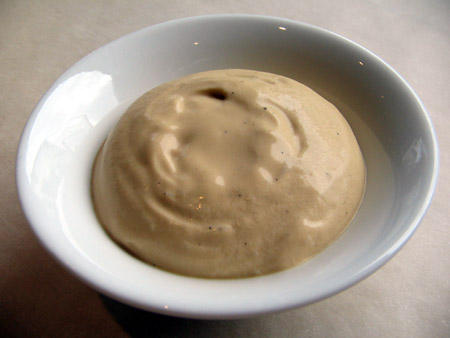
Based on some googling of espuma and foam recipes (including Ferran Adria’s coffee espuma), I figured that the following should work:
2 dL coffee
2 sheets of gelatine
3 dL heavy cream
sugar/vanilla sugar
Soak gelatine in cold water. Strain. Dissolve gelatin sheets in the hot coffee and stir in sugar while heating. Cool. Add heavy cream. Filter through a fine meshed sift (just in case there should be any undissolved sugar, gelatin or particles) into a 0.5 L iSi gourmet whipper. Screw on top and charge with a cream charger. Shake 2-3 times and leave in fridge for a couple of hours. Hold whipper upside down, shake once to displace mixture towards the nozzle in case it is stuck and dispense. Texture is soft and silky. Tastes delicious!
Some more chemistry: The cream chargers contain dinitrogen oxide (N2O) which is less polar than carbon dioxide (CO2), and hence more soluble in fat (such as heavy cream for instance). Another reason why carbon dioxide is not used in this recipe is probably that when it dissolves, some carbonic acid is formed which could curdle milk based products if pH drops to much and also influence taste (but carbonated milk has actually been marketed!). The idea of using dinitrogen oxide for soda/beer has also been explored.

I tasted carbonated milk a couple of years back: The carbonisation made it almost impossible to to taste anything. When shaking the fizz out of the milk the taste was really bad. Mind you, the same holds for Coca Cola aka Coke-and probably any other soft drink…
Does it have to be a gourmet whip because I have a profi? Thanks for the inspiring blog.
No – you can use whatever whipper you have 🙂
So what is the differance between the profi and the gourmet? Thanks
how long before the foam liquefies. do you think it will keep longer than egg white based foams.
thank you for your blog!
now if you added TG like in the hydrocloids collection it would be heat stable, right? and if you used TG GS or TG YG the ph variation from the dinitrogen oxyde wouldnt have such an ” extream” affect, because of thier ph tollerance, right. well maybe not the TG YG sience its used maily in the production of cheese, but small % may possibly work. i think it is one to revisit, may be worth it to make a ” hot coffee foam” on top of an iced cappucino?
derek: Yes – transglutaminase can stabilize a gelatin foam and make it heat stable. As far as I know dissolution of dinitrogen oxide (N2O) in water will not change it’s pH significantly (contrary to what happens when CO2 is dissolved in water). To make hot stable foams you could of course also turn to other hydrocolloids. The table in “Texture” is a good place to start when looking for the right hydrocolloid.